1lumen selects and reviews products personally. We may earn affiliate commissions through our links, which help support our testing.
Fenix E12 v2 review
Table of contents
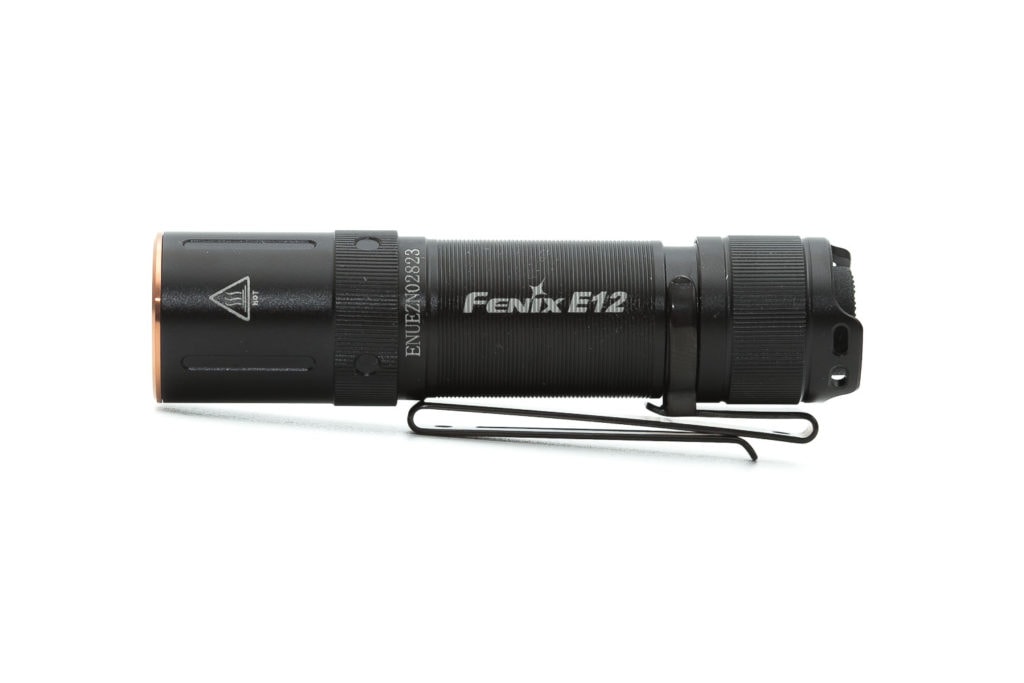
Specifications
| Brand/model | Fenix E12 v2 |
|---|---|
| LED | MATCH CA18 |
| Lumens | 160 lm |
| Beam intensity | 1133 cd |
| Battery config. | 1*AA |
| Material | Aluminum |
| Modes | 3 |
| Blinkies | N/A |
| Reflector | Special |
| Waterproof | IP68 |
| Review date | October 2020 |
INTRODUCTION:
This is the 2nd edition of the Fenix E12 flashlight. The first one is actually from 2014 and had a maximum output of 130 lumens. The 2nd edition (from 2020) got an increased output of up to 160 lumens. This is not really earth shattering, but a nice little upgrade. Still 160 lumens is pretty low for an AA flashlight.
Package quality.
The E12 v2 package can only be opened once. Inside the package you can find the following:
- The Fenix E12 v2 flashlight
- 2-way pocket clip (attached)
- Lanyard
- O-rings
- Warranty card
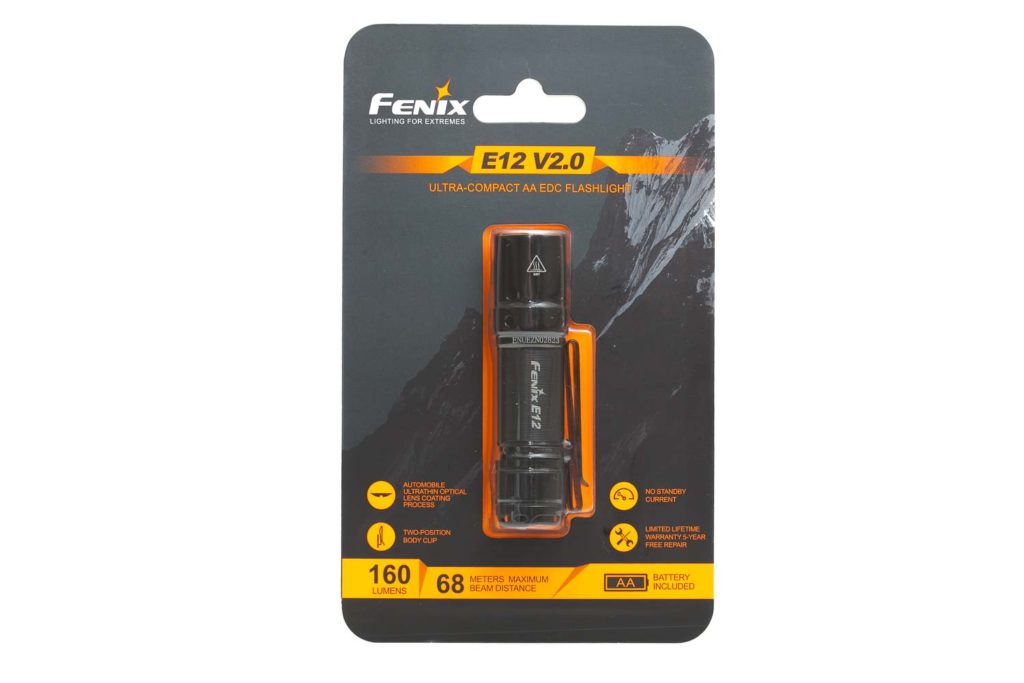
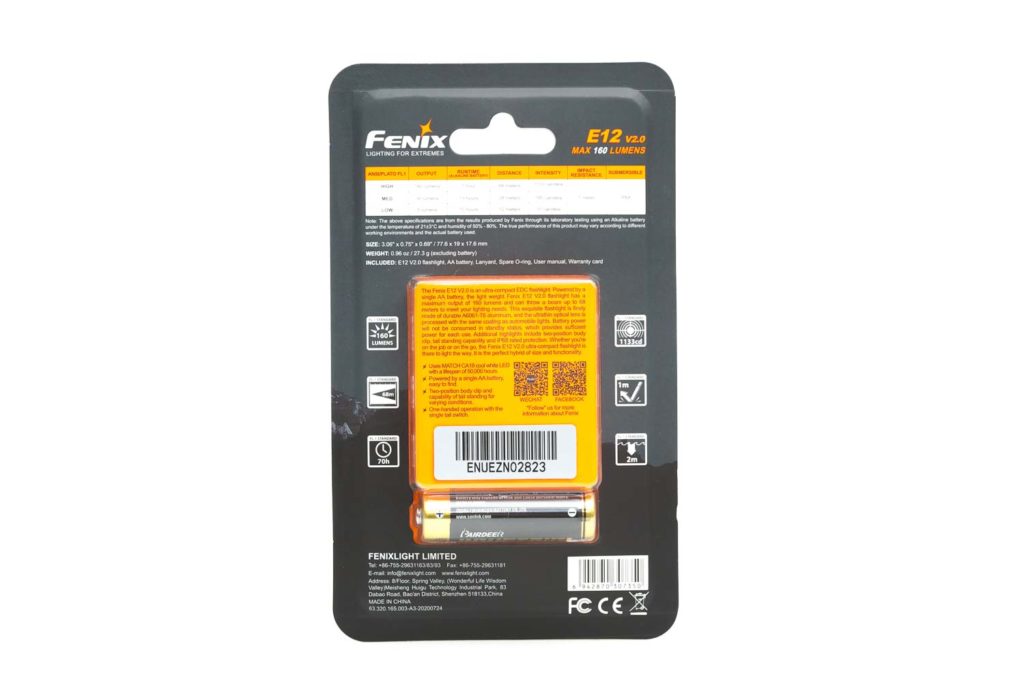
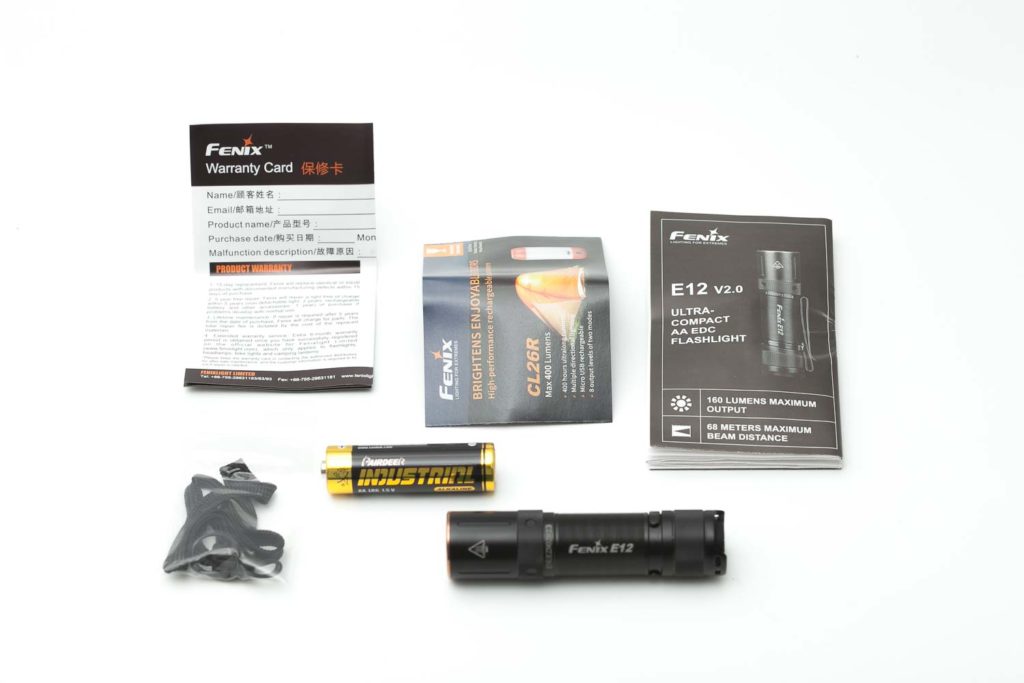
Handling of the light
When you open the box, one of the first things you’ll notice is the size. It’s one of the smallest AA flashlights currently on the market. Especially when you consider it has a tail switch.
The body doesn’t have much knurling so it can feel a little slippery. Keep in mind that we are talking about a very tiny flashlight, so most people don’t use it as their main work light. If you are an AA flashlight fan, read this review carefully.
The clip itself give extra grip is a two-way clip so you can clip it onto your cap and into your pocket without turning the clip around like you had to do back in the day.
Operating the E12 v2 is pretty easy with the single switch in the rear. It’s a reverse-clicky switch that works well. It’s not very stiff and easy to operate. And since it’s a reverse-clicky, you can’t use it for signaling or morse coding.. in case you wondered.
Although there are 2 cutout near the tailcap to operate the switch, it’s still possible to make it tailstand. Add your diffuser and you have a nice bedside light.
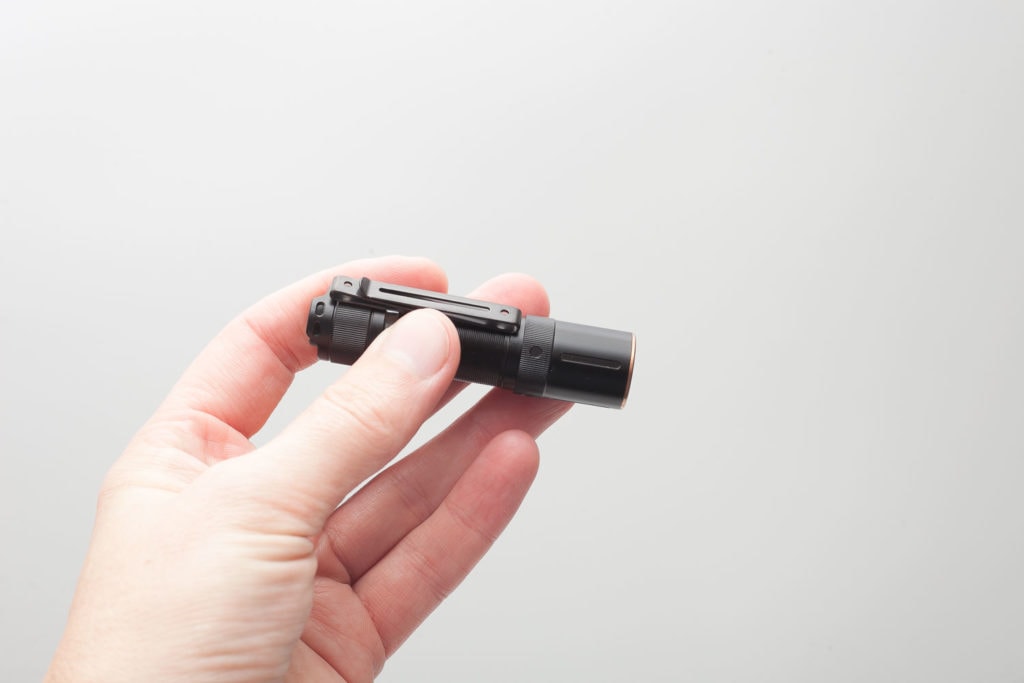
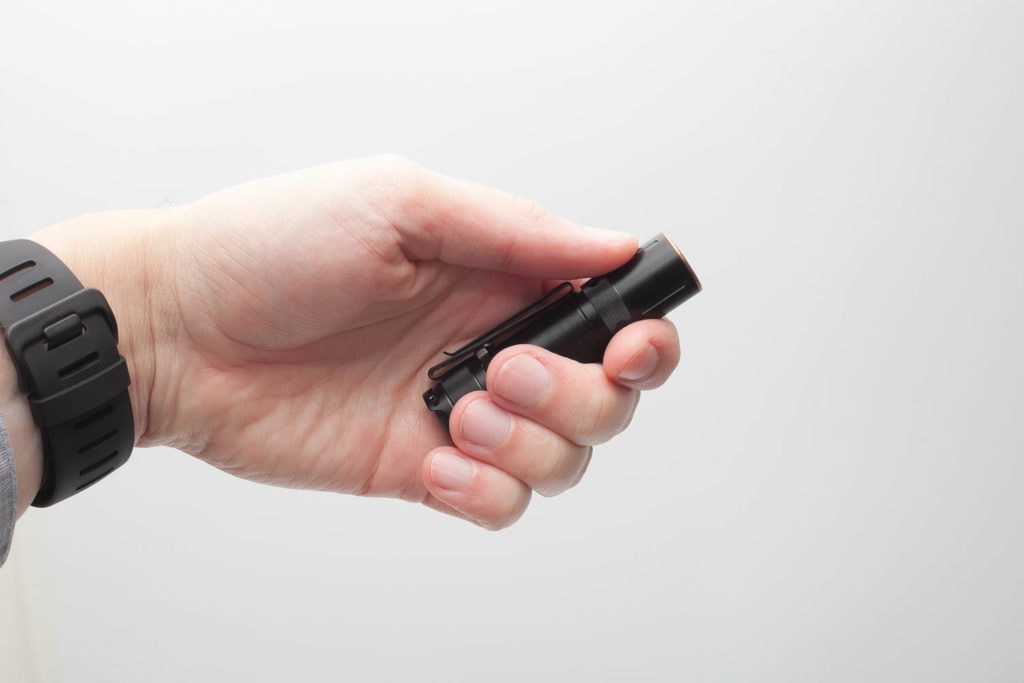
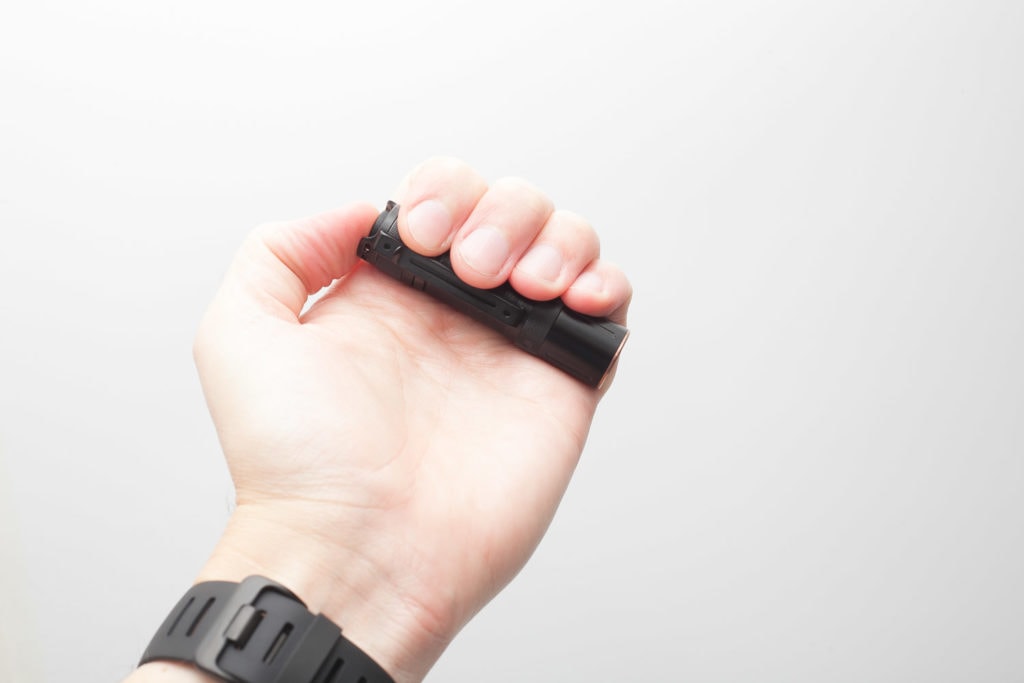
Build Quality, Knurling, Threads, and anodization
I understand if you skip this part of the review. It’s quite boring because 99% of the lights we review are built okay-perfect. One of the reasons for that is because we choose the lights we want to review. Reviews cost us a few hours of typing and a few hours of testing, so I personally don’t want to review every light under the sun.
The E12 v2 is no exception. It’s built well, and everything fits together well. No wobbling, no moving parts. The threads are lubed and run smoothly. No complaints whatsoever.
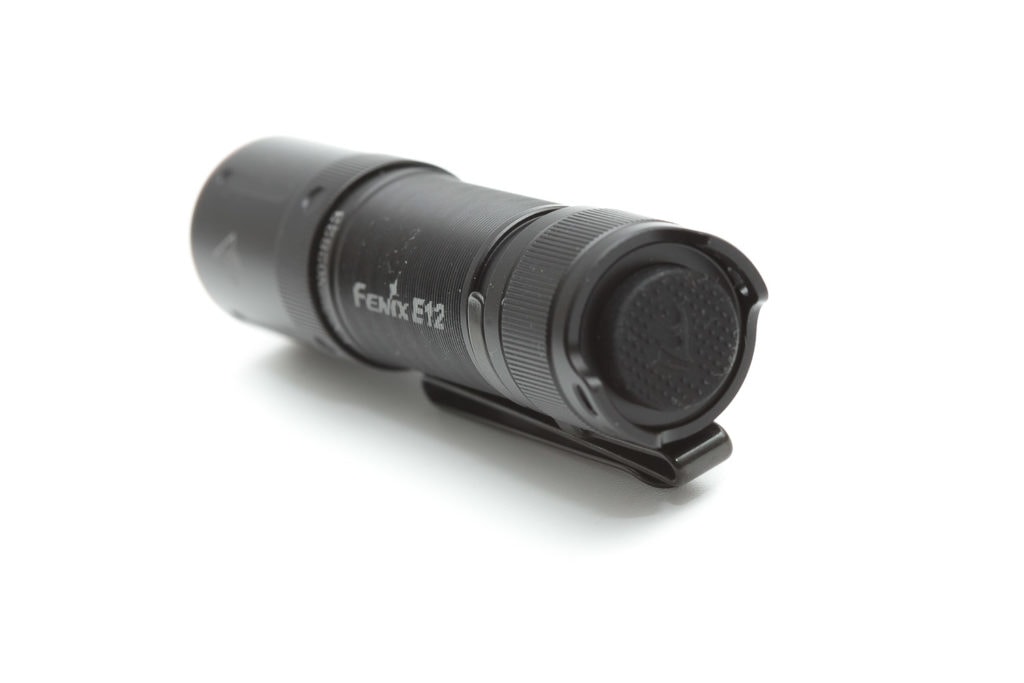
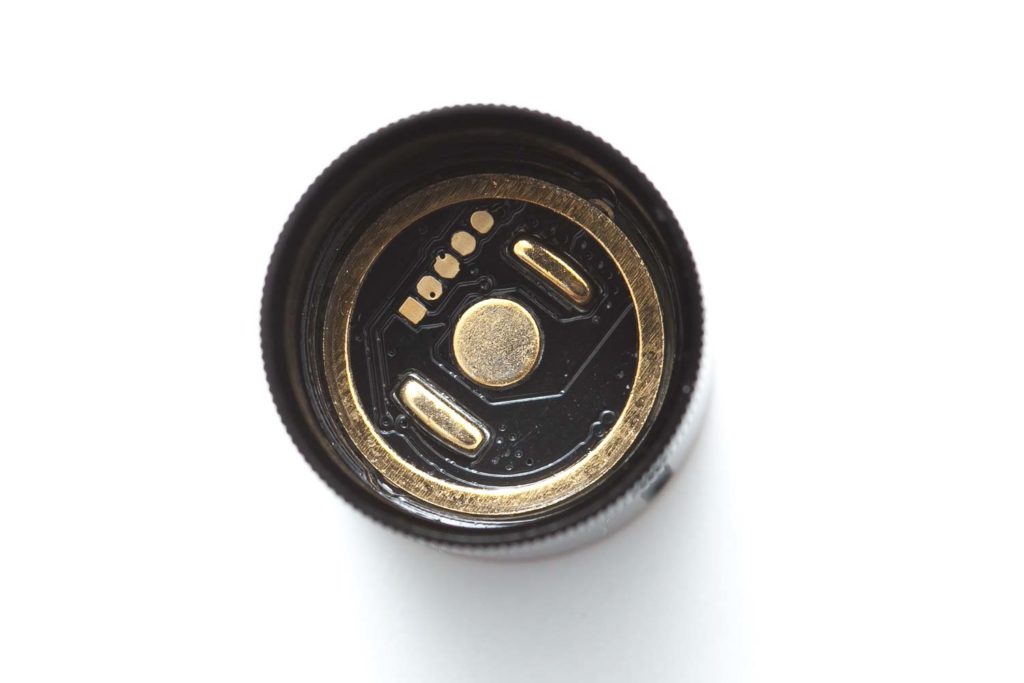
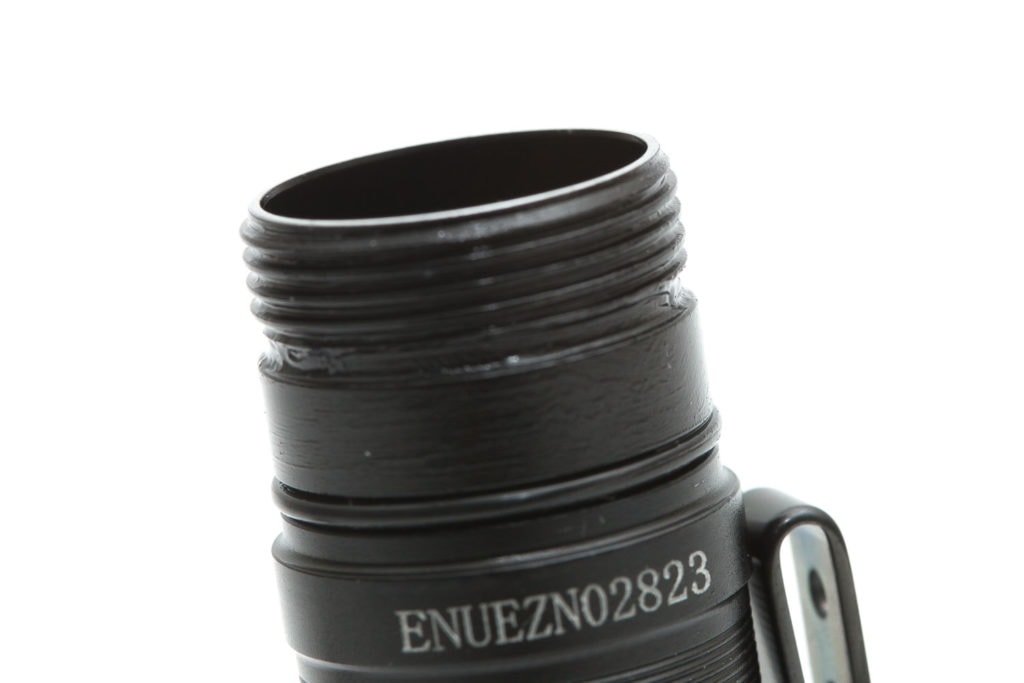
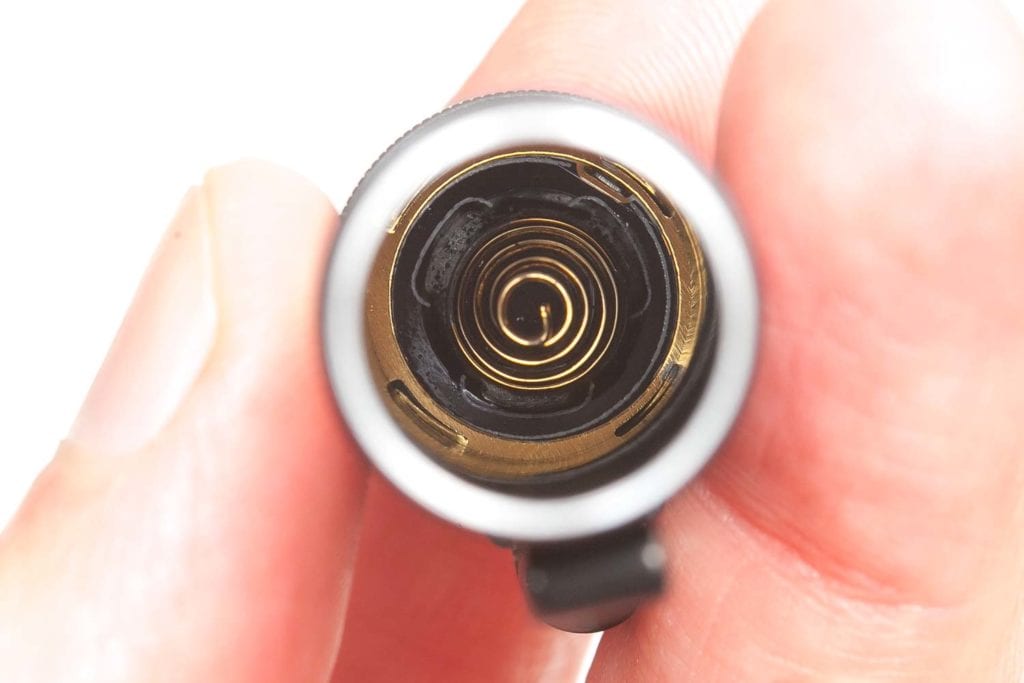
LED, LENS, BEZEL, AND REFLECTOR
You won’t be able to choose your favorite LED, tint or bin, like you can do with the small manufacturers. Fenix doesn’t usually give the option and by default uses cool white emitters. In case you care about this, you probably already know this.
The E12 v2 also has a cold white LED, and I had no idea what type of LED it was until I read the manual. I know, men don’t need manuals, but for a review, it’s important to glance over the details at least once. And then I saw the type of LED they used, it’s called a MATCH CA18 Cool White LED. I never heard of this brand, nor this type of LED.
Anyways, if you look at the pictures below, you can see that the reflector/TIR optic looks really cool. It does look like the LED is a little bit off-center. The color temperature doesn’t seem too cold, but it’s hard to guess without proper tools.
The copper looking bezel isn’t removable. I tried to remove it but to no avail. It turns, but it doesn’t unscrew.
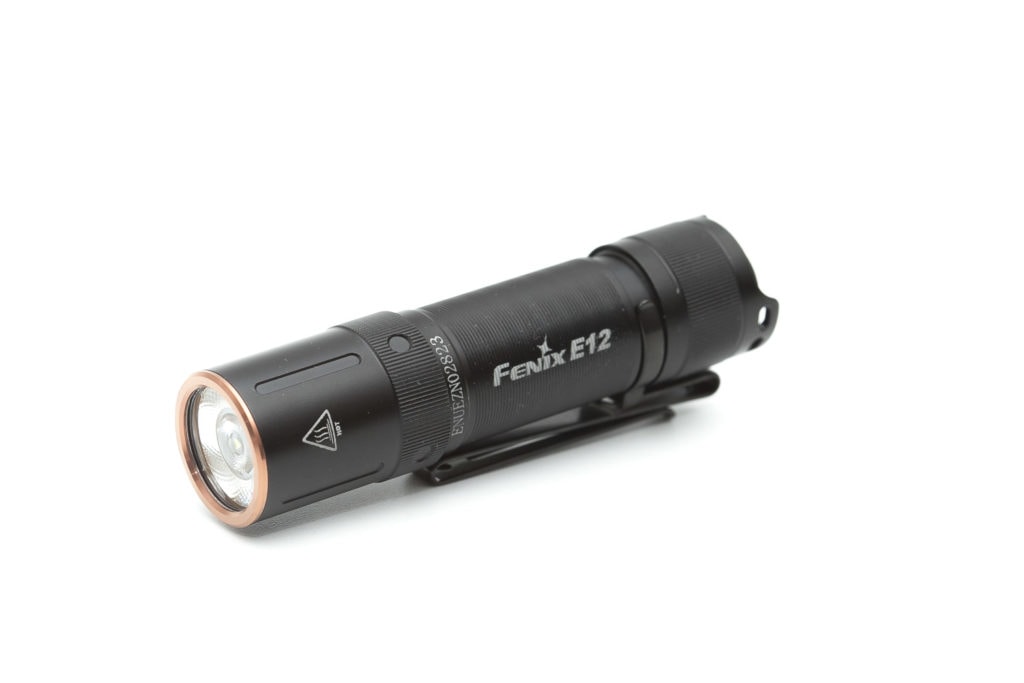
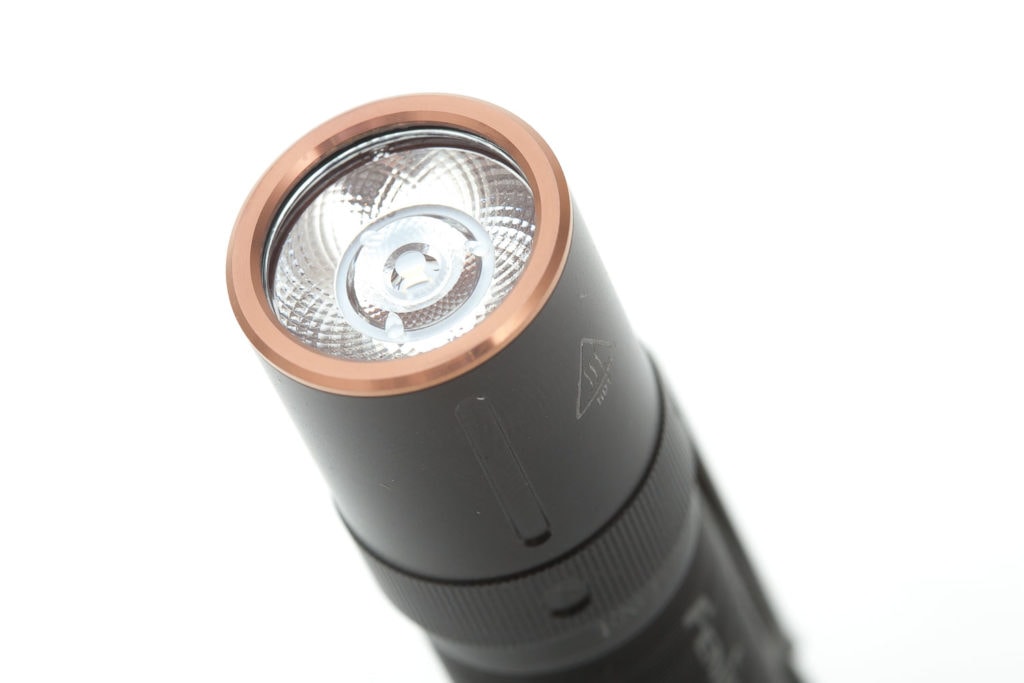
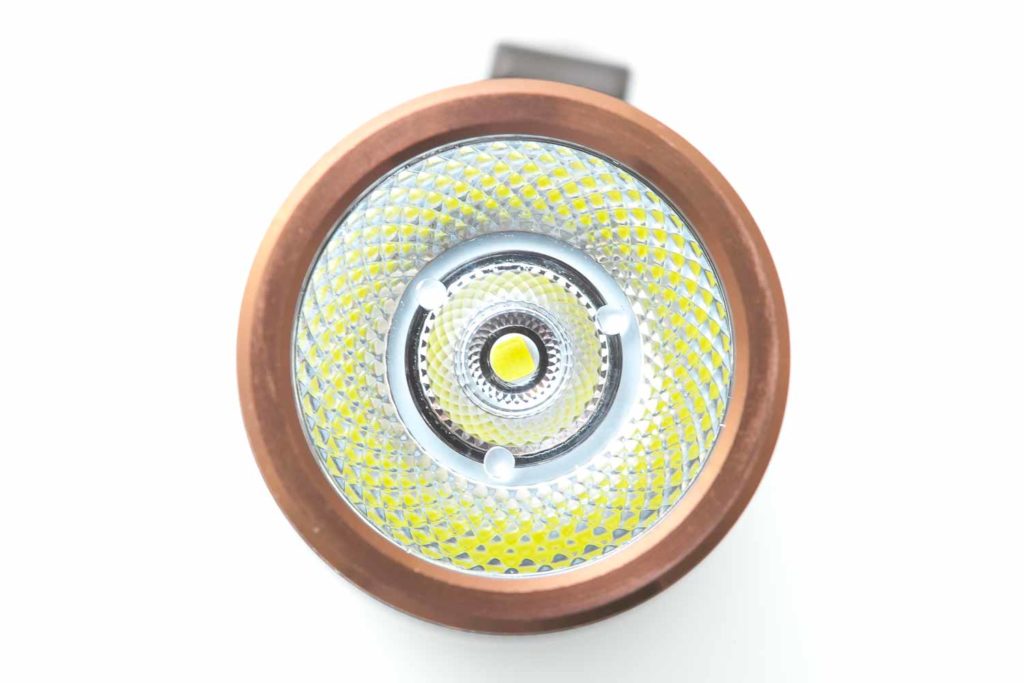
Dimensions
- Length: 77.8 mm / 3 ”
- Head diameter: 19.4 mm / 0.76 ”
- Body diameter: 17.6 mm / 0.69 ”
Weight:
- Empty: 28.1 g / 0.99 oz
- With battery: 54.7 g / 1.93 oz
EDC and Keychain flashlights
Size compared to other EDC flashlights and small flashlights
From left to right: Fenix E12 v2, Enogear AA, Lumintop EDC05, Lumintop Tool AA 2.0, Lumintop EDC AA.
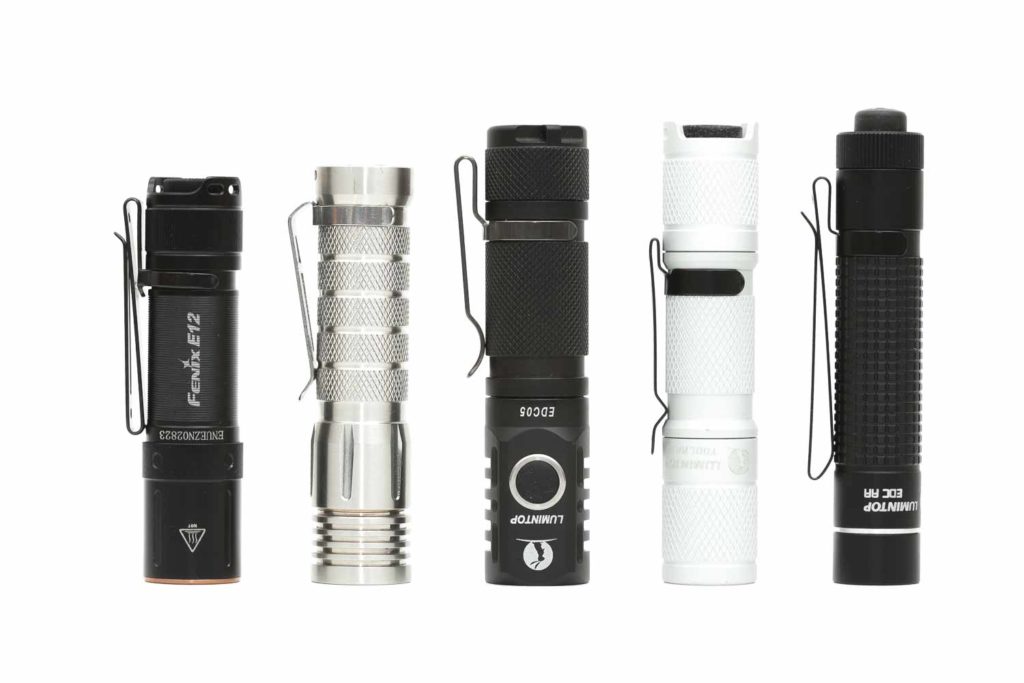

Driver & User Interface:
After reviewing Anduril Firmware based flashlights, it sometimes feels like a relief to find this kind of simple UI. No hidden modes, no blinkies, nothing. Just a simple old-fashioned 3-modes UI.
Available modes:
- Low, Medium, High
From OFF:
- Half-press: nothing (it’s a reverse clicky switch)
- Single-click: Turn on in Low
- Double click: just turns off again.
From ON:
- Half-press: Cycle through the menu from Low to High
- Single-click: turns off
Mode memory:
- No, it always starts in Low
Blinky modes menu:
- Nope
Low battery warning:
- Nope
Lock-out mode:
- Nope
PWM:
- Nope
Batteries & Charging
Fenix includes an Alkaline battery named Pairdeer Industrial and it’s difficult to know how it performs in certain circumstances since it’s not rechargeable. I used it to measure the High mode, and that’s it. I wasn’t able to test the lumen output or throw with it. I used a Duracell AA battery instead and Eneloop as my calibration.
So, the flashlight itself has no built in charge system. Oh, and keep in mind it doesn’t accept 14500 lithium ion batteries 4.2V. It does however accept lithium AA like Energizer 1.8V
Performance
Lumen measurements:
All output numbers are relative for my home-made Integrating Sphere. It is set up with an Extech SDL400 Lux Meter for measurements including a Kenko PRO1D ND-16 filter. The base measurement is done with a Convoy S2+ that was tested at 255 lumens.
All of my readings were taken from a fully-charged Panasonic Eneloop AA 1900mAh.
| Mode | Specs | 30 sec | start |
|---|---|---|---|
| Low | 5 | 3.86 lm | 3.86 lm |
| Med | 30 | 25 lm | 25 lm |
| High | 160 | 151 lm | 152 lm |
Fenix’s numbers are always pretty trustworthy.
Next up is an overview of its performance on a single Duracell AA battery
| Mode | Specs | @start |
|---|---|---|
| Low | 5 | 3.86 |
| Med | 30 | 25 |
| High | 160 | 152 |
As you can see, they are the same as a NiMH battery, like the white Eneloop AA used above.
Runtime:
The runtime test was done with the 50cm integrating sphere, including the Kenko Pro1D ND-16 filter and Extech SDL400 data logging Lux Meter.
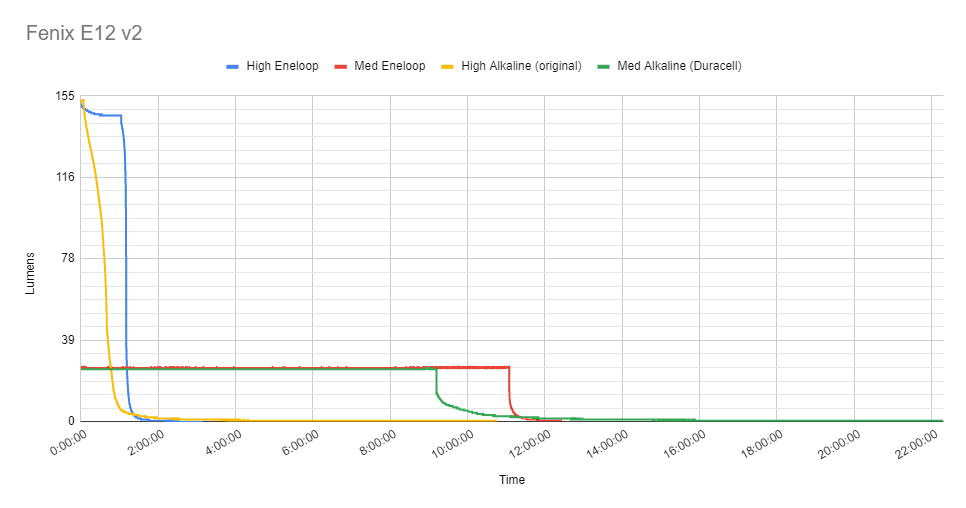
The yellow line is the battery Fenix included in the package. You can see a bit difference between the Alkaline cell and Eneloop AA. Alkaline batteries can run for days in a row at the lowest energy consumption. NiMH are much better at high power. The following graph is showing the first 2 hours, so you can notice the big difference between a rechargeable AA and the Alkaline battery.
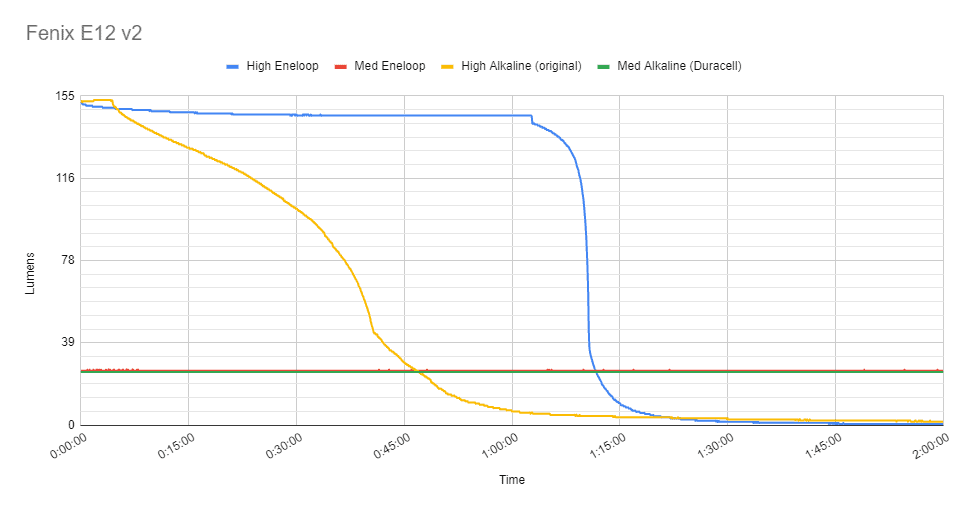
The Alkaline batteries run a very long time, many, many hours after it dropped to about 1-3 lumens. But you definitely see the difference in output between the 2 types of batteries.
AA Flashlight performance comparison chart
Below is an interactive runtime graph of several AA flashlights I tested. These are measured with AA Eneloop batteries. Even though some of the lights work with 14500 batteries, the numbers are solely for Eneloops.
Some of the following measurements were taken directly from the runtime graph below, instead of the manual measurements, simply because I only have old data for some. So they can differ from the measurements in the review.
| Flashlight (and Link) | At turn on | 30 sec | 10 minutes |
|---|---|---|---|
| Acebeam Pokelit AA Gray | 345 | 321 | 128 |
| Acebeam Tac AA | 322 | 306 | 101 |
| Convoy T2 | 210 | 215 | 233 |
| Cyansky P10 | 335 | 212 | 133 |
| Fenix E12 v2 | 152 | 151 | 148 |
| Lumintop EDC AA | 214 | 170 | 169 |
| Lumintop Tool AA 2.0 | 345 | 248 | 212 |
| Manker E05 | 140 | 140 | 140 |
| Olight i5R EOS | 167 | 158 | 126 |
| Olight i5R EOS HiCRI | 169 | 158 | 126 |
| Reylight Pineapple v4 | 247 | 203 | 177 |
| Zebralight SC53C N | 261 | 235 | 181 |
Here’s a closeup graph of the first 10 minutes
Throw Measurement
Measurements were taken both indoors and outdoors with a professional Hagner E4-X Lux Meter, tested with Eneloop battery
| Mode | Specs | I measured | Meters | Yards |
|---|---|---|---|---|
| Med | 185 cd | 200 cd | 28 | 31 |
| High | 1133 cd | 1300 cd | 72 | 79 |
In this table, you can see that it overperforms a little. The difference is small.
Beamshots
For the following beamshots I used a Canon EOS 5D Mk2 and a 50mm lens. manual settings: ISO1600, 1/30sec , F4, 5000K


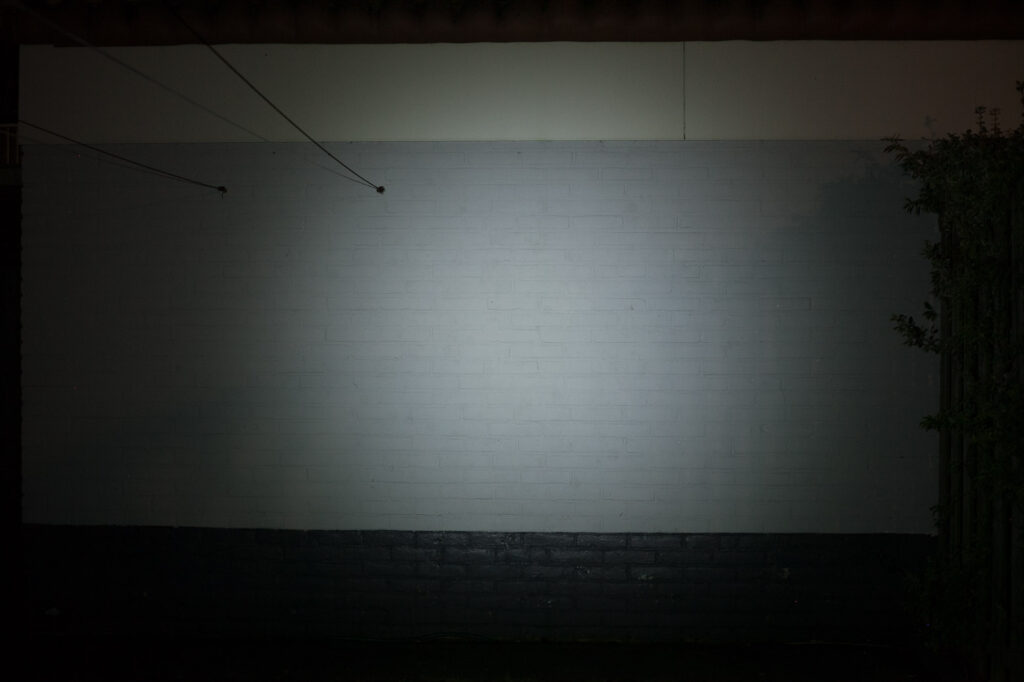

Disclaimer: This flashlight was sent to me for review at no cost, by Fenix. I have not been paid to review, nor have I been holding back on problems or defects.
OVERALL CONCLUSION
Pros
- Very easy UI
- Always starts in Low
- No PWM
- No hidden modes
- No strobe
- Very small in size (could also be a con)
- 2-way pocket clip
Cons
- Very small (could also be a Pro)
- Doesn’t work with 14500s
- 160 lumens is pretty low, but great to be used by kids
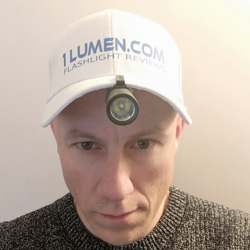
5 stars: ★★★★★
I can totally recommend this flashlight for every person. It has a very simple UI that always starts in Low and runs for more than 1 hour in High. No, this isn’t a powerhouse, but it does what it needs to do. Nothing really exciting, but a great little flashlight.
Buy Fenix E12 v2 at a discount
Get 10% off every purchase at Fenix Lighting US, by using our exclusive 1lumen discount code: 1lumen10
1lumen selects and reviews products personally. We may earn affiliate commissions through our links, which help support our testing.